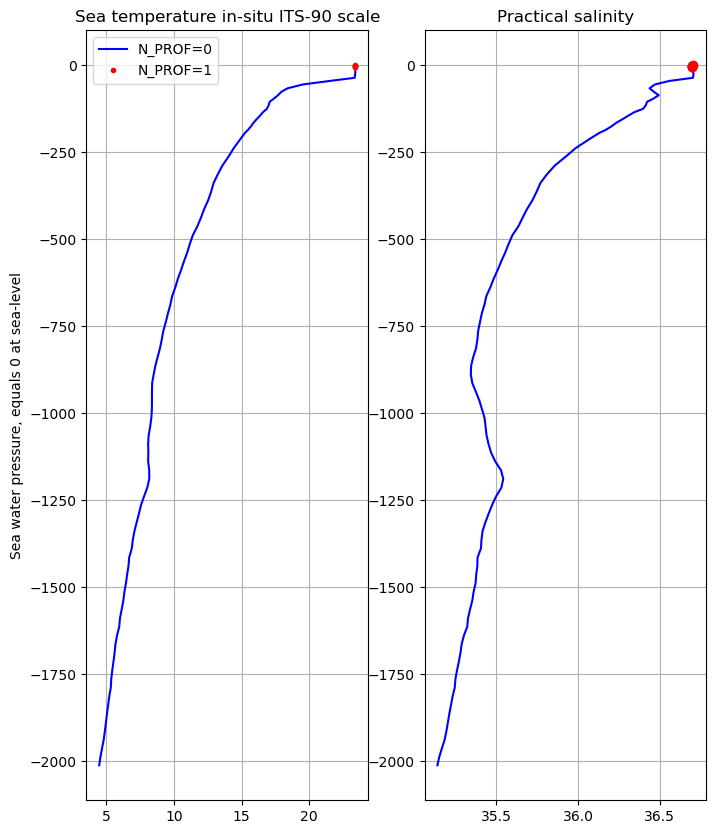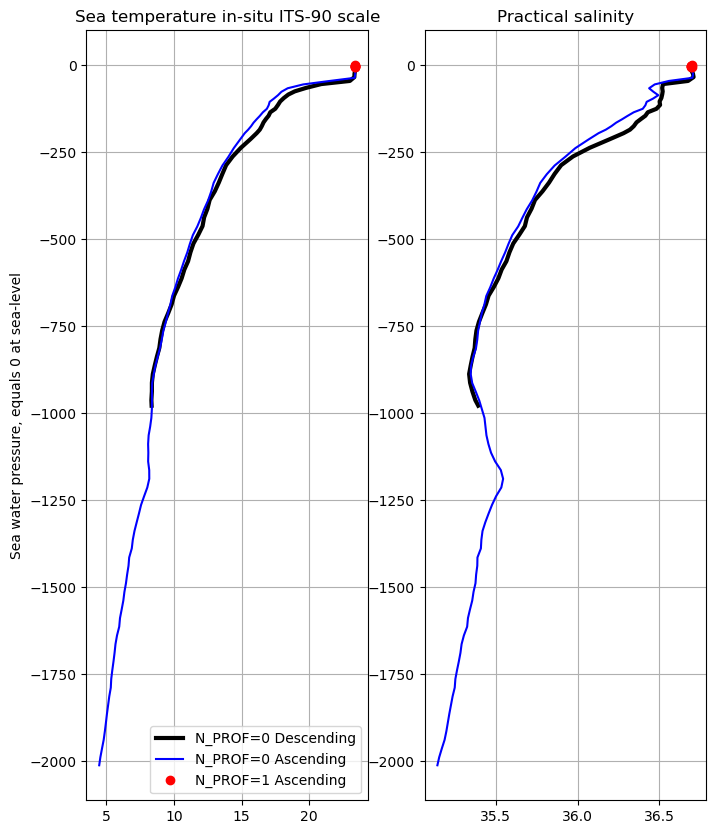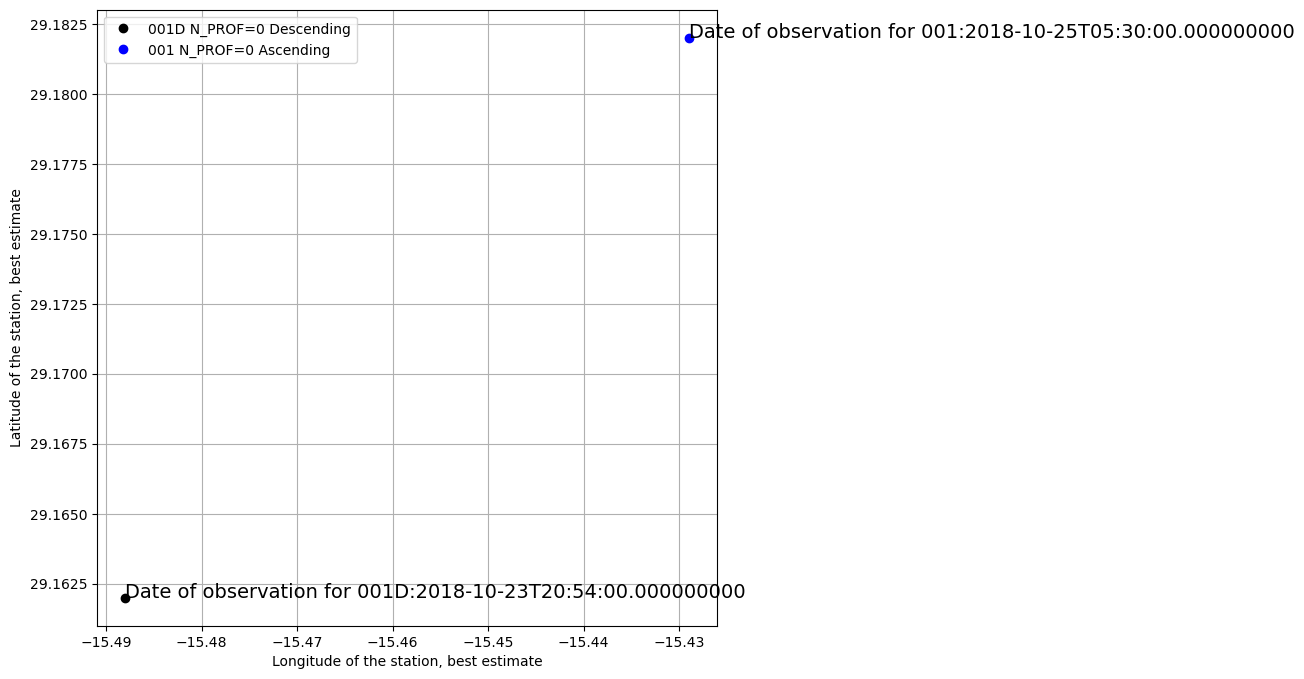Reading an Argo cycle#
The first cycle#

An Argo cycle starts with a descent towards deep water, usually from the surface, and ends after the next programmed ascent to the surface (see the figure). During the surface interval, data transmission typically occurs but it is not a requirement for a cycle to have occurred. If it occurs, the cycle ends after the full surface interval has been completed.
Nowadays Argo floats can measure different parameters, however, we will focus on what is called the Argo core mission, this is observations of temperature, salinity and pressure down to 2000 meters of depth. These observations are called CTD (Conductivity, Temperature and Depth - since these are the actual observations and from them it is possible to compute Salinity)
The measurements are performed during ascent, occasionally during descent, and subsurface measurements during parking are sometimes performed.
Each cycle of a float has a unique number, increased by one after each ascent to the surface or shallow water. Float cycle numbers usually start at 1. The next cycles are increasing numbers (e.g. 2, 3,…N). Some floats report a cycle 0, called launch cycle, which is shorter than the regular cycles. The cycle time is therefore regular only for later profiles and may be variable if the float is reprogrammed after its deployment.
For those floats with cycle 0, if there is an initial descend profile, it would be on cycle 0.
First, import libraries.
import numpy as np
import xarray as xr
import netCDF4
from matplotlib import pyplot as plt
%matplotlib inline
Let’s read the data from the first cycle of float 6901254. Note taht at the time we dowloaded the data there were only Real-Time observations, that is the reason the file name begins with and “R”
cy1 = xr.open_dataset('../../Data/202107-ArgoData/dac/coriolis/6901254/profiles/R6901254_001.nc')
Printing the object gives you summary information.
cy1
<xarray.Dataset> Size: 18kB
Dimensions: (N_PROF: 2, N_PARAM: 3, N_LEVELS: 97,
N_HISTORY: 3, N_CALIB: 1)
Dimensions without coordinates: N_PROF, N_PARAM, N_LEVELS, N_HISTORY, N_CALIB
Data variables: (12/64)
DATA_TYPE object 8B ...
FORMAT_VERSION object 8B ...
HANDBOOK_VERSION object 8B ...
REFERENCE_DATE_TIME object 8B ...
DATE_CREATION object 8B ...
DATE_UPDATE object 8B ...
... ...
HISTORY_QCTEST (N_HISTORY, N_PROF) object 48B ...
PARAMETER (N_PROF, N_CALIB, N_PARAM) object 48B ...
SCIENTIFIC_CALIB_EQUATION (N_PROF, N_CALIB, N_PARAM) object 48B ...
SCIENTIFIC_CALIB_COEFFICIENT (N_PROF, N_CALIB, N_PARAM) object 48B ...
SCIENTIFIC_CALIB_COMMENT (N_PROF, N_CALIB, N_PARAM) object 48B ...
SCIENTIFIC_CALIB_DATE (N_PROF, N_CALIB, N_PARAM) object 48B ...
Attributes:
title: Argo float vertical profile
institution: CORIOLIS
source: Argo float
history: 2019-01-15T11:25:18Z creation; 2019-01-15T11:25:24Z...
references: http://www.argodatamgt.org/Documentation
user_manual_version: 3.1
Conventions: Argo-3.1 CF-1.6
featureType: trajectoryProfile
decoder_version: CODA_027dThis is an ideal occasion to remember one of the main properties of the netCDF format seen previously: it is a Self-Describing format, hence it contains all the metadata necesary. The name for the core observations, temperature, salinity (obtained from conductivity internally in the float) and pressure down to 2000 dbar (remember the floats measure pressure, but as and wasy rule of thumb 1 dar is 1 meter), are TEMP, SALT and PRES. Although we could inspect the previous print-out of the cy1 dataset, we can use the data itself:
print(f"The core variables are: \n TEMP {cy1.TEMP.long_name} \n PSAL {cy1.PSAL.long_name} and \n PRES {cy1.PRES.long_name}")
The core variables are:
TEMP Sea temperature in-situ ITS-90 scale
PSAL Practical salinity and
PRES Sea water pressure, equals 0 at sea-level
In this file, the variables TEMP_ADJUSTED, PSAL_ADJUSTED and PRES_ADJUSTED are also shown, which correspond to data that has gone through the second stage of quality control. However, here we keep the focus on the Real-Time data in section Real-Time and Delayed mode data.
print(f"The dimesions of TEMP are:\n {cy1.TEMP.dims[0]}:{cy1.TEMP.shape[0]} \n {cy1.TEMP.dims[1]}:{cy1.TEMP.shape[1]}")
The dimesions of TEMP are:
N_PROF:2
N_LEVELS:97
We note that for for the first cycle there are two profiles (N_PROF=2) and 97 vertical levels… lets plot them:
fig, ax = plt.subplots(1,2,figsize=(8,10))
#Temperature
ax[0].plot(cy1.TEMP[0],-cy1.PRES[0],'b-',label='N_PROF=0')
ax[0].plot(cy1.TEMP[1],-cy1.PRES[1],'r.',label='N_PROF=1')
ax[0].set_title(cy1.TEMP.long_name)
ax[0].set_ylabel(cy1.PRES.long_name)
ax[0].grid()
ax[0].legend()
#Salinity
ax[1].plot(cy1.PSAL[0],-cy1.PRES[0],'b-',label='N_PROF=0')
ax[1].plot(cy1.PSAL[1],-cy1.PRES[1],'ro',label='N_PROF=1')
ax[1].set_title(cy1.PSAL.long_name)
ax[1].grid()

Within the cycle file, there are two profiles. The first one (N_PROF=0 in blue) is measured during its ascend from the 2000 dbar (remember that Argo measurements are done in pressure levels, however as a rule of thumb 1 dbar is aproximately 1 meter) to 5 dbar and it constitutes the core Argo program. The second profile (N_PROF=1 in red) only measures the top 5 dbar (from the surface to 5 meters depth) and it is mostly used to calibrate the Sea Surface Temperature observations done from satellites.
Once again all the information is in the netcf file, the data variable VERTICAL_SAMPLING_SCHEME contains all the details:
print(f"The first profile is the: { str(cy1.VERTICAL_SAMPLING_SCHEME[0].astype(str).values) }")
The first profile is the: Primary sampling: averaged [10 sec sampling, 25 dbar average from 2000 dbar to 200 dbar; 10 sec sampling, 10 dbar average from 200 dbar to 10 dbar; 10 sec sampling, 1 dbar average from 10 dbar to 5.5 dbar]
print(f"The second profile is the: {cy1.VERTICAL_SAMPLING_SCHEME[1].astype(str).values}")
The second profile is the: Near-surface sampling: averaged, unpumped [10 sec sampling, 1 dbar average from 5.5 dbar to surface]
Ago floats may measure several profiles in each cycle, however, as a rule of thumb the first profile is always the core mission Argo CTD profile (2000 dbar - 5 dbar). In the case of this float there is an additional second profile, with higher resolution (10 sec sampling and 1 dbar average) but unpumped. The sensor of conductivity (for salinity) doesn’t pump water through to avoid contamination or biodeposition from the surface. The data from this second profile is used, mostly, for calibrations of SST observations from satellites.
In the Reference table 16: vertical sampling schemes of the Argo Data Management Team. Argo user’s manual. https://doi.org/10.13155/29825 there is a description of all the different options in VERTICAL_SAMPLING_SCHEME. However, a discussion of all of them is beyond the objective of this AoS than focusing on understanding the basic concepts.
The descending profile#
As mentioned before, some floats also make measurements in the first descending phase of the first cycle. The data is in the <R/D>
cy1D = xr.open_dataset('../../Data/202107-ArgoData/dac/coriolis/6901254/profiles/R6901254_001D.nc')
print(f"The dimesions of TEMP are:\n {cy1D.TEMP.dims[0]}:{cy1D.TEMP.shape[0]} \n {cy1D.TEMP.dims[1]}:{cy1D.TEMP.shape[1]}")
The dimesions of TEMP are:
N_PROF:1
N_LEVELS:51
in this case there is only one profile, let’s plot it together with the ascending data (cy1):
fig, ax = plt.subplots(1,2,figsize=(8,10))
#Temperature
ax[0].plot(cy1D.TEMP[0],-cy1D.PRES[0],'k-',label='N_PROF=0 Descending',linewidth=3.0)
ax[0].plot(cy1.TEMP[0],-cy1.PRES[0],'b-',label='N_PROF=0 Ascending')
ax[0].plot(cy1.TEMP[1],-cy1.PRES[1],'ro',label='N_PROF=1 Ascending')
ax[0].set_title(cy1.TEMP.long_name)
ax[0].set_ylabel(cy1.PRES.long_name)
ax[0].grid()
ax[0].legend()
#Salinity
ax[1].plot(cy1D.PSAL[0],-cy1D.PRES[0],'k-',label='N_PROF=0 Descending',linewidth=3.0)
ax[1].plot(cy1.PSAL[0],-cy1.PRES[0],'b-',label='N_PROF=0 Ascending')
ax[1].plot(cy1.PSAL[1],-cy1.PRES[1],'ro',label='N_PROF=1 Ascending')
ax[1].set_title(cy1.PSAL.long_name)
ax[1].grid()

As indicated in the figure, the first descending is only until the parking depth.
Geographical information#
The NetCDF file includes information about the geographical position of the observations (LONGITUDE and LATITUDE) and the date of the observation (JULD).
for variable in ['LONGITUDE', 'LATITUDE' , 'JULD']:
print(f"The {cy1.data_vars[variable].long_name} is in the variable {variable}")
The Longitude of the station, best estimate is in the variable LONGITUDE
The Latitude of the station, best estimate is in the variable LATITUDE
The Julian day (UTC) of the station relative to REFERENCE_DATE_TIME is in the variable JULD
Let’s plot it
fig, ax = plt.subplots(figsize=(8,8))
ax.plot(cy1D.LONGITUDE[0],cy1D.LATITUDE[0],'ko',label='001D N_PROF=0 Descending')
ax.plot(cy1.LONGITUDE[0],cy1.LATITUDE[0],'bo',label='001 N_PROF=0 Ascending')
#ax.set_title(cy1..long_name)
ax.set_xlabel(cy1.LONGITUDE.long_name)
ax.set_ylabel(cy1.LATITUDE.long_name)
ax.text(cy1D.LONGITUDE[0],cy1D.LATITUDE[0],'Date of observation for 001D:'+cy1D.JULD[0].values.astype(str), fontsize=14)
ax.text(cy1.LONGITUDE[0],cy1.LATITUDE[0],'Date of observation for 001:'+cy1.JULD[0].values.astype(str), fontsize=14)
ax.grid()
ax.legend();

The 2 ascending profiles in 001 have, obviously, the same time stamp:
print(cy1.JULD[0].values.astype(str))
print(cy1.JULD[1].values.astype(str))
2018-10-25T05:30:00.000000000
2018-10-25T05:30:00.000000000
Note that for some floats there is a <R/D>
Meta information in the cycle file#
The NetCDF file for each cycle includes a lot of additional information about each one of the profiles in it. Let’s take a look at the basic information.
print(f"For cycle {cy1D.CYCLE_NUMBER.astype(int).values} The {cy1D.DIRECTION.long_name} (DIRECTION) is {cy1D.DIRECTION.values.astype(str)}")
print(f"For cycle {cy1.CYCLE_NUMBER.astype(int).values} the {cy1.DIRECTION.long_name} (DIRECTION) is {cy1.DIRECTION.values.astype(str)}")
For cycle [1] The Direction of the station profiles (DIRECTION) is ['D']
For cycle [1 1] the Direction of the station profiles (DIRECTION) is ['A' 'A']
A is for ascending and D for descending.
And all the meta information of the float, and for each profile within each cycle, among others:
for variable in ['PLATFORM_NUMBER','DATA_CENTRE','PROJECT_NAME','PI_NAME']:
print(f"The {cy1.data_vars[variable].long_name} ({variable}) is {cy1.data_vars[variable].values.astype(str)}")
The Float unique identifier (PLATFORM_NUMBER) is ['6901254 ' '6901254 ']
The Data centre in charge of float data processing (DATA_CENTRE) is ['IF' 'IF']
The Name of the project (PROJECT_NAME) is ['ARGO SPAIN '
'ARGO SPAIN ']
The Name of the principal investigator (PI_NAME) is ['Pedro Velez '
'Pedro Velez ']
We can also access the dimession that define the profile
for key in cy1.sizes.keys():
print(key,cy1.sizes[key])
N_PROF 2
N_PARAM 3
N_LEVELS 97
N_HISTORY 3
N_CALIB 1
N_LEVELS is the number of vertical levels, i.e. in pressure. N_PROF is the number of profiles within the cycle, as we saw previously. N_PARAM is the number of parameters, 3 for this float: TEMP, PSAL and PRES
Later we will explain N_CALIB and N_HISTORY
Meta data#
There is a lot of additional meta information in the <FloatWmoID>_meta.nc file
Mdata = xr.open_dataset('../../Data/202107-ArgoData/dac/coriolis/6901254/6901254_meta.nc')
Always, the basic information appears in all the netcdf files of an Argo float:
for variable in ['PLATFORM_NUMBER','DATA_CENTRE','PROJECT_NAME','PI_NAME']:
print(f"The {Mdata.data_vars[variable].long_name} ({variable}) is {Mdata.data_vars[variable].values.astype(str)}")
The Float unique identifier (PLATFORM_NUMBER) is 6901254
The Data centre in charge of float real-time processing (DATA_CENTRE) is IF
The Program under which the float was deployed (PROJECT_NAME) is ARGO SPAIN
The Name of the principal investigator (PI_NAME) is Pedro Velez
and some examples of additional information in the <FloatWmoID>_meta.nc file
for variable in ['FIRMWARE_VERSION','BATTERY_TYPE','DEPLOYMENT_PLATFORM','CONFIG_PARAMETER_NAME','SENSOR_SERIAL_NO']:
print(f"The {Mdata.data_vars[variable].long_name} ({variable}) is {Mdata.data_vars[variable].values.astype(str)}")
The Firmware version for the float (FIRMWARE_VERSION) is n/a
The Type of battery packs in the float (BATTERY_TYPE) is LITHIUM
The Identifier of the deployment platform (DEPLOYMENT_PLATFORM) is ANGELES ALVARI?O
The Name of configuration parameter (CONFIG_PARAMETER_NAME) is ['CONFIG_CycleTime_hours '
'CONFIG_ParkPressure_dbar '
'CONFIG_ProfilePressure_dbar '
'CONFIG_DescentToParkPresSamplingTime_seconds '
'CONFIG_Direction_NUMBER ']
The Serial number of the sensor (SENSOR_SERIAL_NO) is ['n/a ' 'n/a ' 'n/a ']
The full descritpion of all the variables is in the Argo user’s Manual
